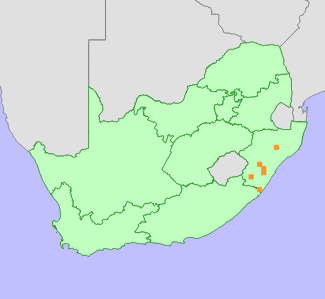|
Scientific Name | Sisyranthus fanniniae N.E.Br. |
Higher Classification | Dicotyledons |
Family | APOCYNACEAE |
National Status |
Status and Criteria | Vulnerable B1ab(iii)+2ab(iii) |
Assessment Date | 2007/05/17 |
Assessor(s) | C.R. Scott-Shaw, A. Nicholas, I.M. Johnson & L. von Staden |
Justification | This genus is very poorly known and data for this species are uncertain. However, the estimated range is very restricted (EOO 200-1400 km²), there are very few records which indicate that it is rare (estimated less than 10 locations) and there is evidence of continuing decline in the habitat from afforestation in the vicinity of the type locality and from overgrazing by livestock elsewhere. Members of the Asclepiadineae are, despite their milky latex, very sensitive to grazing and tend to disappear from heavily grazed areas. |
Distribution |
Endemism | South African endemic |
Provincial distribution | KwaZulu-Natal |
Range | Impendle to Dargle, possibly also Underberg and Nsikeni. |
Habitat and Ecology |
Major system | Terrestrial |
Major habitats | Midlands Mistbelt Grassland, Moist Coast Hinterland Grassland, Drakensberg Foothill Moist Grassland, Pondoland-Ugu Sandstone Coastal Sourveld |
Description | Montane grassland, 1600-1800 m. |
Threats |
| Afforestation is a serious ongoing threat in the vicinity of the type locality, and much of Dargle Farm and surrounds are under plantations. An adjoining farm has recently been converted to plantations. There are however some good grasslands remaining on Carlisle, Selsley and Maritzdal (farms formerly part of the Dargle estate), where this species could still be found if efforts were made to locate it (I. Johnson pers. comm.).
Around Mpendle much of the land is communally owned, and overgrazing and subsistence farming are causing degradation of grasslands (C.R. Scott-Shaw pers. comm.). Members of the Asclepiadineae are, despite their milky latex, very sensitive to grazing and tend to disappear from heavily grazed areas (A. Nicholas pers. comm.).
At Ntsikeni much of the mountain slopes are also under forestry plantations. |
Population |
Population trend | Decreasing |
Assessment History |
Taxon assessed |
Status and Criteria |
Citation/Red List version | | Sisyranthus fanniniae N.E.Br. | VU B1ab(iii) | Raimondo et al. (2009) | | Sisyranthus fanniniae N.E.Br. | VU | Scott-Shaw (1999) | | Sisyranthus fanniniae N.E.Br. | Vulnerable | Hilton-Taylor (1996) | |
Bibliography |
Brown, N.E. 1909. Asclepiadeae. In: W.T. Thiselton-Dyer (ed). Flora Capensis IV Section I (Vacciniaceae to Gentianeae):518-1036. Lovell Reeve & Co., Ltd., London.
Hilton-Taylor, C. 1996. Red data list of southern African plants. Strelitzia 4. South African National Botanical Institute, Pretoria.
Pooley, E. 2005. A field guide to wild flowers of KwaZulu-Natal and the Eastern Region. Natal Flora Publications Trust, Durban.
Raimondo, D., von Staden, L., Foden, W., Victor, J.E., Helme, N.A., Turner, R.C., Kamundi, D.A. and Manyama, P.A. 2009. Red List of South African Plants. Strelitzia 25. South African National Biodiversity Institute, Pretoria.
Scott-Shaw, C.R. 1999. Rare and threatened plants of KwaZulu-Natal and neighbouring regions. KwaZulu-Natal Nature Conservation Service, Pietermaritzburg.
|
Citation |
| Scott-Shaw, C.R., Nicholas, A., Johnson, I.M. & von Staden, L. 2007. Sisyranthus fanniniae N.E.Br. National Assessment: Red List of South African Plants version 2024.1. Accessed on 2025/12/04 |
 Comment on this assessment
Comment on this assessment


